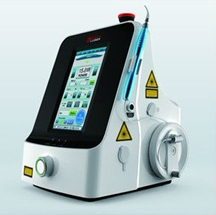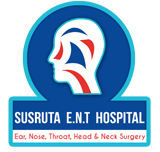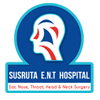LASERS IN EAR, NOSE AND THROAT SURGERY

What is LASER?
Laser is an abbreviation for Light Amplification by Stimulated Emission of Radiation. The laser is now universally accepted as technologically the most advanced tool in various specialities of surgery. CO2, Diode and KTP Lasers are commonly used in certain E.N.T Surgeries.
What are the complications of Laser?
Laser is a high energy beam of light. Laser usage is safe however rare complications like Eye Injuries, Skin injuries, damage to surrounding structures like oral cavity, vocal cord s and trachea can occur. Rarely damage to endotracheal tube can lead to fire from direct or reflected laser beam. To avoid these complications judicious precautions are taken.
Advantages of Laser
 Bloodless dissection
Bloodless dissection
 Precise Surgery
Precise Surgery
 Immediate tissue destruction by instantaneous vaporization. Reduces spread of cancer
Immediate tissue destruction by instantaneous vaporization. Reduces spread of cancer
 Minimal instrumentation required to deliver the laser beam
Minimal instrumentation required to deliver the laser beam
 Minimal damage to adjacent tissue with minimal post-operative swelling
Minimal damage to adjacent tissue with minimal post-operative swelling
Applications of the CO2 laser in ENT Surgery:
 Larynx: Done with Microlaryngoscopy for Juvenile Laryngeal Papillomas, Laryngeal web, Vocal nodules, Capillary haemangioma, T1 Carcinoma of mobile vocal cords, Arytenoidectomy and Subglottic stenosis
Larynx: Done with Microlaryngoscopy for Juvenile Laryngeal Papillomas, Laryngeal web, Vocal nodules, Capillary haemangioma, T1 Carcinoma of mobile vocal cords, Arytenoidectomy and Subglottic stenosis
 Oral cavity: Debulking of large inoperable tumours, Tonsillectomy in cases of blood dyscrasias, superficial lesions and palatal surgeries like Uvulopalatopharyngoplasty.
Oral cavity: Debulking of large inoperable tumours, Tonsillectomy in cases of blood dyscrasias, superficial lesions and palatal surgeries like Uvulopalatopharyngoplasty.
 Nose: Inverted Papilloma, haemangioma, Nasal polyps, Turbinectomy and Nasal tumours. This is combined with nasal Endoscopy
Nose: Inverted Papilloma, haemangioma, Nasal polyps, Turbinectomy and Nasal tumours. This is combined with nasal Endoscopy
 Tracheobronchial tree: Respiratory Papillomatosis, Tracheal Stenosis, Granulation tissue, Bronchial adenoma
Tracheobronchial tree: Respiratory Papillomatosis, Tracheal Stenosis, Granulation tissue, Bronchial adenoma
 Ear: Myringotomy, Stapedectomy, Acoustic Neuroma
Ear: Myringotomy, Stapedectomy, Acoustic Neuroma
ENDOSCOPIC SINUS AND SKULL BASE SURGERY.CSF LEAK REPAIR
Sinuses around the nose (Para nasal Sinuses) are empty air filled spaces in the facial and skull bones. They have mucosal lining similar to that of nose and upper respiratory tract. The frontal sinuses are situated in the forehead bones, the Maxillary sinuses in cheek bones, Ethmoid sinuses are situated between and behind the eye sockets and the Sphenoid sinuses are further back in the skull base. In some individuals the mucosal lining in sinuses may become obstructed due to polyps or may be infected leading to allergic or infective sinusitis. The symptoms include facial pains, headaches, fever, cloudy or greenish yellow nasal discharge, nasal congestion, post nasal drip and rarely facial swelling.
What is Endoscopic Sinus Surgery?
Endoscopic sinus surgery is a procedure designed to increase the amount of air flowing through the Nose and Sinuses and allows mucus to drain properly out of the nose. Endoscopic Sinus Surgery permits the direct visualization and treatment of various parts of the nasal cavities, Sinuses and Skull base with special lighted Endoscopes.The Endoscopes and powered instruments are a recent advance in the field of Rhinology which are utilized to observe and treat the complex anatomy of the sinuses and skull base which are not normally visible or accessible. This surgery does not involve cutting through the skin, as it is performed entirely through the nostrils. The procedure is safely done under general Anaesthesia.
Major complications of Endoscopic Sinus surgery include?
 Blindness or loss of vision
Blindness or loss of vision
 CSF leak
CSF leak
 Meningitis
Meningitis
 Intracranial bleed
Intracranial bleed
 Damage to the internal carotid artery
Damage to the internal carotid artery
SURGERY FOR SNORING
Snoring is noise produced by vibrating upper air way while sleeping due to obstructed air movement.
Impact of Snoring
Severe snoring can be the cause of various health problems including high Blood Pressure, Heart failure and reduces the life expectancy. It causes significant social impact on the patient and family and can reduce the quality of life. Poor sleep is attributed to loss of concentration, poor memory and reduced productiveness. Snoring is no longer considered a simple problem. The impact of snoring varies from simple disturbance to your spouse or persons sleeping next to you to severe form of OSA which may affect your health. Obstructive sleep apnoea is temporary stopping of breathing due to severe obstruction of upper airway while sleeping. Loud snoring is often interrupted by silent phases where there is obstruction of airway. The OSA is defined as stopping of breathing for 10 seconds or more occurring for 7 times or more in one hour sleep. The OSA severity can vary from mild to severe. The OSA reduces the oxygen levels in your blood and does not allow you to go into deep sleep. This results in poor quality of sleep, waking up tired and day time sleepiness. It also puts significant burden on your heart and lungs. Sleep Study (Poly somnography): is an important investigation to assess the quality of your sleep. It analyses the depth of your sleep, Oxygen levels in your body, heart monitoring and number of Sleep Apnoeas.
Persons who snore have at least one of the following problems
 Poor muscle tone (lack of tightness) in the muscles of the tongue and throat
Poor muscle tone (lack of tightness) in the muscles of the tongue and throat
 Poor muscle tone (lack of tightness) in the muscles of the tongue and throat
Poor muscle tone (lack of tightness) in the muscles of the tongue and throat
 Abnormal facial skeletal structure
Abnormal facial skeletal structure
 Excessive length of the soft palate and uvula
Excessive length of the soft palate and uvula
 Obstructed nasal airways
Obstructed nasal airways
Management of Snoring and Sleep Apnoea
Life style modifications: Weight reduction, Healthy diet, Exercise, stopping smoking and alcohol intake.
Non- Surgicals Treatments:
In selected cases Home use CPAP (Continious Positive Airway Pressure) Ventilator can reduce the respiratory effort and help the patients with OSA. Few patients may benefit from Mandibular advancement splints.
Surgery:
In selected cases Surgery may help patients with OSA and Snoring. There are several Surgical modalities reshaping or reducing the Soft Palate, Base of Tongue, or altering the facial skeletal structure to improve the airway. At Susruta Ent Hospital we use CO2 / Diode Laser, Coblation and Radio Channelling devises to improve the airway
PHONO-SURGERY FOR VOICE DISORDERS
For human beings Voice is a main form of communication and for some, voice is the most important tool for their profession (Teachers, sales persons, lawyers, doctors, actors, singers, Instructors and public speakers etc).
Professional and non- professional voice users can have problems with voice at some stage in their life. We understand that voice disorders can provoke extreme anxiety for an individual, particularly for those whose livelihood is dependent on the voice quality. For a lot of people Voice quality is linked to self esteem. Our multidisciplinary approach with Vocal check, Speech and Language Therapist input, Phono-surgeon and voice rehabilitation provides comprehensive assessment and management of Voice problems. We use modern equipment like Stroboscopy and rigid and fibre optic diagnostic endoscopes to evaluate the voice. In selected cases like resistant vocal nodules, Vocal polyps, Vocal cord paralysis or suspected malignancy surgical intervention is more appropriate.

ADVANCED MICRO EAR & SKULL BASE SURGERY
Early detection of hearing loss in young children is extremely important. Children who are deaf or hard of hearing need early intervention to stimulate language and speech development. Unfortunately, traditional behavioral techniques for identifying hearing loss in infants and young children is often difficult and time consuming, and is not always reliable. Otoacoustic Emission Testing is a new and accurate method of diagnosing hearing loss in very young children.
The Micro ear surgeries performed include
STAPEDECTOMY : Three bones in the middle ear (malleus- Incus- Stapes) function like a chain transmitting sound from Ear drum to inner ear. The smallest bone in the body- Stapes, sometimes becomes fixed by disease resulting in deafness. Stapedectomy is a surgical procedure to correct this problem which helps patient to hear normally. Prof. Appa Rao has performed more than 1000 stapedectomy operations successfully.
Middle ear Effusions in Children (Glue ears causing deafness) Grommet Insertions long standing ear discharge
 Myringoplasty
Myringoplasty
 Mastoidectomy
Mastoidectomy
 Ossiculoplasty
Ossiculoplasty
Vertigo not responding to Medical treatment
 Endolymphatic Sac Decompression
Endolymphatic Sac Decompression
 Labirynthectomy
Labirynthectomy
 Vestibular Nerve Section
Vestibular Nerve Section
 Gentamicin instillation into middle ear
Gentamicin instillation into middle ear
Facial Nerve Palsy
 Facial Nerve Decompression and Grafting
Facial Nerve Decompression and Grafting

PEDIATRIC E.N.T SURGERY
Ear, Nose, Throat surgeries for children beyond the age of 2 years are performed at Susruta Ent Hospital. The common ENT Problems in Children include obstructive Sleep Apnoea from Adenoid and Tonsil enlargement, Foreign body ingestion and inhalation, Glue ear (fluid in middle ear impairing hearing), External ear Malformations, Preauricular cysts and sinuses etc.

HEAD & NECK CANCER SURGERY
Head and Neck cancer is an emerging major public health problem in India. Head and Neck cancer accounts for 30% of all reported cancers in India. Life style, particularly smoking and alcohol intake are the main risk factors. These cancers affect nasal passages, sinuses, mouth, throat, larynx, swallowing passages, salivary glands, thyroid glands and skin cancers on the scalp, face or neck. Early diagnosis and management is essential for curing the cancer in most instances. We provide a multidisciplinary approach to the management of Head and Neck cancers which includes Oncologist and Radiologist input along with ENT, Plastic and Onco-surgeons to provide expert, personalized care to patients with head and neck cancer.
RHINOPLASTY
Rhinoplasty is a surgical procedure that refines a nose's size and shape, and improves obstructed breathing is called Rhinoplasty or Septorhinoplasty. Nothing has a greater impact on how a person looks than the size and shape of the nose. The goal of rhinoplasty is to create a natural looking nose which fits in harmoniously with the other facial features.
Susruta Ent Hospital is a center for treatment of ear, nose and throat & head and neck problems, and hence patients can advantageously be treated for both functional and cosmetic concerns at the same time. Patients will need to undergo both cosmetic and functional assessment. The functional assessment includes the taking of a full history and an endoscopic examination of the nose, sinuses and throat. CT scans of the nose and paranasal sinuses may be needed as well.
Issues such as nasal obstruction, sinusitis, allergies and snoring can all be addressed, while improving the appearance of the nose. Patients are often as delighted with their improved breathing and nasal function as with the cosmetic result.
What Can Rhinoplasty Do?
 Reduce a nose that is too large or long.
Reduce a nose that is too large or long.
 Narrow a nose that is too wide
Narrow a nose that is too wide
 Straighten a nose that is crooked.
Straighten a nose that is crooked.
 Reshape the tip.
Reshape the tip.
 Improve the angle between the nose and the upper lip for a more youthful look.
Improve the angle between the nose and the upper lip for a more youthful look.
 Alter unsatisfactory changes that occur with age.
Alter unsatisfactory changes that occur with age.
Increase the air flow where obstructions in the nose are causing breathing and sinus problems.
The Consultation: Factors taken into consideration
 The degree of the cosmetic concern.
The degree of the cosmetic concern.
 The degree of function of nasal structures
The degree of function of nasal structures
 The structure of the nose, both internally and externally.
The structure of the nose, both internally and externally.
 How the shape of the nose relates to the contour of the face.
How the shape of the nose relates to the contour of the face.
 How the shape of the nose relates to other facial features.
How the shape of the nose relates to other facial features.
 Skin texture and thickness.
Skin texture and thickness.
 The individual ability of skin tissue to heal.
The individual ability of skin tissue to heal.
 Age and ethnic background, as this may affect healing.
Age and ethnic background, as this may affect healing.
 Medical history.
Medical history.
Rhinoplasty planning means creating a nose that is right for that patient's face. Matters such as age and gender, and the racial and cultural background of the patient have to be carefully considered. The personality of the patient is also a very important factor when planning changes to the face.
How is it Done?
There are two ways of doing this procedure : closed and open structure rhinoplasty. The open-structure method is favoured. Open-structure rhinoplasty is not frequently executed, but we believe it is the best way to perform nose surgery. It involves a small incision between the nostrils, which leaves an almost imperceptible scar. This technique affords the best access and results, especially for a twisted nose and for tip deformities. The tip of the nose is the most difficult part of the procedure to achieve a good result with because it is made of soft cartilage, which has to be sculpted into place. Open-structure rhinoplasty is ideal for these candidates.
First, incisions are made in the inside of the nose, where they are not visible. For open structure approach an incision may be made in the area of the skin separating the nostrils.
Underlying amounts of bone and cartilage are removed or adjusted to provide the nose's new shape.
A small cast is placed on the nose after the surgery is completed. A very small absorbable dressing may be placed just inside the nostrils for one day. Large packs are not used.
Rhinoplasty is performed under a general anaesthetic and takes around two hours. When patients wake up, they are often surprised that pain isn't a big feature in the postoperative period, but they may have black eyes. Patients are required to wear a splint over the top of their nose and have a little stitch under their nose until both are removed at seven days.
After two weeks patients usually look completely normal but the final result can take a few months; and up to a year if it has been an extensive procedure. These final changes are usually only minor and can only be noticed by the surgeon and patient. In the short term there is a risk of bleeding and infection, but these are most unlikely. It is also rare for the patient not to be satisfied with the outcome, particularly if preoperative preparation has been thorough.
Other surgeries of the nose and paranasal sinuses too can be combined in case the functional outcome is to be improved simultaneously.
Conclusion
The nose serves as the axis of the face: the static structure around which the expression, dynamism and beauty of the face find axis. For cosmetic surgery to succeed, the surgeon must strike a delicate balance between artistry and medical science. Perhaps more than any other procedure, rhinoplasty highlights the delicacy of both aspects of surgery - the art and the science - and the interconnectedness of form and function. A better nose tends to improve your health AND your looks.
The information available about this procedure is extensive. The best method of determining your personal options is to schedule a personal consultation
The information in this article is only intended as an introduction to this procedure and should not be used to determine whether you will have the procedure performed nor as a guarantee of the result.









